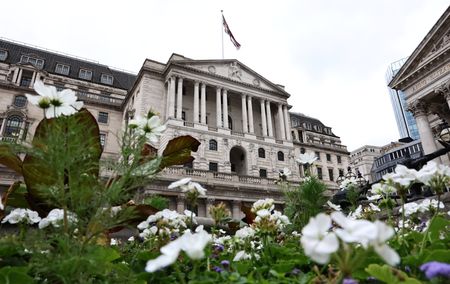By David Milliken
LONDON (Reuters) -The Bank of England said on Thursday it estimates that its programme to cut its bond holdings may have added as much as a quarter of a percentage point to the cost of 10-year British government borrowing, slightly more than it thought a year ago.
Britain’s central bank bought 875 billion pounds ($1.17 trillion) of gilts between 2009 and 2021 to support the economy through successive crises. It has reduced that debt pile by more than 300 billion pounds since 2022, through a mix of bond sales and allowing existing bonds to mature.
Each August, the BoE assesses the impact of the programme over the past year, before its Monetary Policy Committee in September sets the pace at which bond holdings should fall over the following 12 months.
Since October 2024 the BoE has reduced its holdings by 100 billion pounds – largely due to 87 billion pounds of gilts which matured. Market participants polled by the BoE earlier this year expected the stockpile to drop by 75 billion pounds in the 12 months from October 2025.
In a report published after its August MPC meeting, the BoE revised up its estimate of the total impact of its quantitative tightening programme on 10-year gilt yields to 0.15-0.25 percentage points from 0.1-0.2 percentage points a year ago. This reflected the extra QT over the past year, it said.
‘GRADUAL’ SALES
BoE Deputy Governor Dave Ramsden said at a press conference that the central bank intended to stick with its existing approach to QT, which included conducting gilt sales in a “relatively gradual and predictable manner”.
But he said it was too soon to give more detailed guidance on the future pace of QT.
Market analysts at U.S. bank Citi said the report and Ramsden’s comments made them more sure in their view that the BoE would cut the annual pace of QT to 75 billion pounds next month, and had led to modest price gains for longer-dated gilts on expectations of fewer sales.
“Prudence alone suggests a slower pace, with either a subtle shift shorter by adjusting the longer maturity buckets to 7-15 years and 15 years-plus or just ending long sales completely,” they said.
Ten-year gilt yields have risen by about 3.25 percentage points since the start of QT in February 2022 and by 0.55 percentage points over the past year.
Thirty-year gilt yields have risen more sharply, however, up by nearly a full percentage point over the last 12 months, and some economists think the BoE could skew its sales away from these gilts, or even stop them entirely.
“We are very cognisant of developments in gilt markets, particularly at the long end. We have seen that spread between 30-year and 10-year widen,” Ramsden said, but added that other bond markets had seen similar moves.
The BoE’s assessment noted that sales of long-dated gilts could have a bigger impact on liquidity due to reduced demand in the market from pension funds.
“These same shifts in the gilt market could pose a risk that QT has a greater impact on market functioning than previously,” it said.
($1 = 0.7454 pounds)
(Editing by Catherine Evans)











